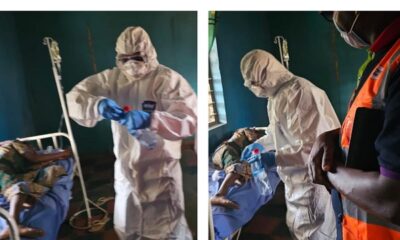Health
Diseases cost the African Region $2.4 trillion a year, WHO reveals
The World Health Organization (WHO) estimates that nearly 630 million years of healthy life were lost in 2015 due to the diseases afflicting the population across its 47 Member States in Africa, now amounting to a loss of more than 2.4 trillion international dollars ($) from the region’s gross domestic product value annually.
Non-communicable diseases have overtaken infectious diseases as the largest drain on productivity, accounting for 37 per cent of the disease burden. Other culprits for lost healthy years are communicable and parasitic diseases; maternal, neonatal and nutrition-related conditions; and injuries.
Around 47%, or $ 796 billion, of this lost productivity value could be avoided in 2030 if the Sustainable Development Goals related to these health conditions are achieved, WHO found.
“Four years into the implementation of countries’ efforts towards achieving UHC, current average expenditure on health in the Region falls short of this expectation,” the WHO Regional Director for Africa, Dr Matshidiso Moeti, writes in the foreword to A Heavy Burden: The Productivity Cost of Illness in Africa, which was launched during the second WHO Africa Health Forum this week in Cabo Verde.
As a target of Sustainable Development Goal 3, universal health coverage would require countries in the WHO African Region to spend, on average, at least $ 271 per capita per year on health, or 7.5% of the region’s gross domestic product.
According to United Nations Conference on Trade and Development estimates, attaining the 17 Sustainable Development Goals will require spending ranging from $ 1.5 trillion to $ 2.5 trillion per year until 2030, or up to $ 37.5 trillion. Low-income countries will need an additional $ 671 billion dollars ($ 76 per capita on average) until 2030 to attain the health-related Sustainable Development Goals (SDG).
To achieve the health-related SDG targets, countries must invest adequately in the development of resilient national and local health systems to effectively, affordably and efficiently deliver the integrated packages of proven cost-effective interventions contained in relevant programmatic global strategies and plans to target populations in need.
The findings of the WHO study on disease burden suggest that health systems strengthening should focus on rich as well as poor countries and on all ages as well as on the specific disease categories.
Five countries (the Democratic Republic of the Congo, Ethiopia, Nigeria, South Africa and the United Republic of Tanzania) accounted for almost 50% of the total years lost in healthy life (or DALYs) accrued in the WHO African Region.
The unpredictability of public revenues combined with mounting debt pressure is limiting the potential fiscal space that can be made available for health. Private financing sources have filled the gap, but either with out-of-pocket expenses that result in financial hardship or insufficient voluntary private health insurance that is not effective in extending service coverage to those that need it.
As the report emphasizes, achieving the Sustainable Development Goals by 2030, including the target of universal health coverage, will require political will and greater focus on government-led planning and financing for health. It will also necessitate greater outlays from public revenue, reforms to raise additional revenue and strategic purchasing mechanisms. And it will require that people usually left behind be put at the centre of health financing reform.
“This report illustrates how achievement of the critical health SDG targets, including universal health coverage, would contribute to poverty eradication efforts on a large scale, reduce disparities in lifespan, tackle social exclusion and promote political stability and economic development in the WHO African Region,” explains Grace Kabaniha, Health Economist in the WHO Regional Office for Africa. “It also provides much-needed evidence that ministries of health can use in dialogue on resource allocation with ministries of finance. It adds to the body of evidence showing that health is a strategic investment for development.”
Health
Oyo: Tragedy As Bride-to-Be Among Four Dead in Suspected Lassa Fever Outbreak
The Oyo State Ministry of Health has closed two hospitals in Saki West Local Government Area following a suspected outbreak of Lassa fever, which has claimed four lives.
The fatalities, confirmed by the Oyo State Rapid Response Team (RRT), include three males and a 32-year-old female who was preparing for her wedding. The closure of the hospitals aims to contain the spread of the disease and ensure thorough decontamination.
In a press statement issued by the Commissioner for Information and Orientation, Dotun Oyelade, the State Commissioner for Health, Dr. Oluwaserimi Ajetunmobi, revealed that the RRT was dispatched to Saki following distress calls from residents reporting mysterious deaths.
Findings and Immediate Actions
The RRT, comprising health officials, representatives from WHO and the Red Cross, and local health authorities, conducted a comprehensive investigation into the outbreak.
Preliminary findings suggest that an apprentice at one of the affected hospitals, who had recently returned from Iwajowa Local Government Area, might have introduced the infection.
The team disclosed that the deceased exhibited symptoms consistent with Lassa fever, such as craniofacial bleeding. The hospital owner, who was among the deceased, initially self-medicated with antimalarials and antibiotics before seeking hospital care when his condition worsened.
Containment Measures
Both the hospital where the fatalities occurred and the facility that admitted the hospital owner were shut down for decontamination.
Contact tracing efforts are ongoing, focusing on high-risk individuals who had contact with the deceased during their illness or burial.
Affected health workers were trained on Infection Prevention and Control (IPC) protocols, and public awareness campaigns were conducted to educate residents about Lassa fever.
Samples have been collected from a symptomatic individual, pending laboratory confirmation. Line-listing of contacts is underway to identify potential cases and prevent further spread.
Collaborative Efforts
The RRT also paid an advocacy visit to the Okere of Saki’s palace to brief traditional authorities on the situation. Local government officials in Saki West were engaged to coordinate containment strategies.
Reports indicate that while the outbreak initially affected Saki West, it has extended to Iwajowa and Kajola Local Government Areas.
Disease Surveillance and Notification Officers (DSNOs) in the affected LGAs have been instructed to commence preliminary containment measures as the State RRT ramps up its response.
Call for Vigilance
The Ministry of Health has urged residents to remain vigilant, report any symptoms suggestive of Lassa fever, and adhere to preventive measures.
These include proper hygiene practices, avoiding contact with rodents, and seeking medical attention promptly if symptoms arise.
Health
Oyo: Oseni to Launch Mobile Clinic Initiative to Revitalize Rural Healthcare
A member representing Ibarapa East/Ido federal constituency of Oyo State at the House of Representatives, Engr. Aderemi Oseni, has announced a plan to launch a “Mobile Clinic” programme aimed at providing essential healthcare services directly to rural communities across the constituency.
Scheduled to begin in the first quarter of 2025, this initiative underscores Oseni’s commitment to expanding healthcare access, particularly for underserved populations.
Speaking on Saturday at the 10th-anniversary celebration of God’s Knot Hospital in Ologuneru, Ibadan, the lawmaker, who also chairs the House Committee on the Federal Roads Maintenance Agency (FERMA), highlighted the programme’s primary objective: bringing healthcare closer to the people.
“Every community deserves attention; healthcare should never be bound by geographical barriers,” Oseni stated.
He explained that the mobile clinics would deliver essential health check-ups, screenings, and preventive care in remote areas, allowing residents to access quality healthcare without traveling long distances.
As part of his broader healthcare agenda, Oseni informed, through a statement by his media aide, Idowu Ayodele, that he has already facilitated the construction of two fully equipped maternity centers within his constituency, both slated for commissioning before December 2024. He also disclosed plans to establish two modern general hospitals in 2025, further strengthening his commitment to building a healthier community.
The lawmaker expressed interest in collaborating with God’s Knot Hospital on the mobile clinic project, calling for partnerships to support sustainable healthcare initiatives that enhance the quality of life for vulnerable populations in the constituency.
“I resonate deeply with the mission of God’s Knot Hospital,” Oseni shared, adding that such partnerships would significantly improve healthcare in Oyo State”.
The anniversary event attracted distinguished guests, including former Ondo State Governor Dr. Olusegun Mimiko, whom Oseni commended for his contributions to healthcare, particularly through the Mother and Child Hospitals that transformed maternal and child healthcare in Ondo State.
Oseni urged philanthropists, government bodies, and international organizations to support healthcare projects like the upcoming mobile clinics, emphasising that the improvement of healthcare services is a shared responsibility.
Health
NAFDAC Shuts Maiduguri Market Over Sun-Dried Drugs After Flood
The National Agency for Food and Drug Administration and Control (NAFDAC) has ordered the immediate closure of the Gomboru drug market in Maiduguri following severe flooding that submerged the area and contaminated the drugs sold within the market.
In a statement posted on its official X handle, NAFDAC disclosed that the decision was made after reports surfaced that contaminated drugs, which had been washed and sun-dried for resale, were being sold at the market.
“After the recent flooding in Maiduguri that submerged the Gomboru drug market where contaminated drugs were washed and sun-dried for resale, the @DGatNAFDAC ordered the immediate closure of the market to conduct a thorough shop-to-shop removal of these compromised drugs,” the agency wrote.
The flooding, which ravaged Maiduguri, was triggered by the rupture of the Alau dam on the Ngadda River, located 20 kilometers (12 miles) south of the city.
The floodwaters claimed at least 30 lives and displaced 400,000 residents, leaving large parts of the city and surrounding areas in devastation.
NAFDAC’s intervention is aimed at safeguarding public health by preventing the sale and consumption of contaminated drugs.
The agency has mobilized teams to inspect the market and ensure the removal of all compromised pharmaceutical products.
-



 Politics6 days ago
Politics6 days agoOyo Rep. Member, Akinmoyede Appoints Three More Aides
-



 Crime & Court1 week ago
Crime & Court1 week agoEFCC Chair Raises Alarm on Rampant Fraud in Nigeria’s Electricity Sector
-



 Health7 days ago
Health7 days agoOyo: Tragedy As Bride-to-Be Among Four Dead in Suspected Lassa Fever Outbreak
-



 Politics5 days ago
Politics5 days ago#OndoDecides2024: Rep Oseni Hails Aiyedatiwa’s Victory, Commends Residents for Peaceful Polls